Note
Click here to download the full example code
Audio Resampling
This tutorial shows how to use torchaudio’s resampling API.
import torch
import torchaudio
import torchaudio.functional as F
import torchaudio.transforms as T
print(torch.__version__)
print(torchaudio.__version__)
Out:
1.12.0
0.12.0
Preparation
First, we import the modules and define the helper functions.
Note
When running this tutorial in Google Colab, install the required packages with the following.
!pip install librosa
import math
import time
import librosa
import matplotlib.pyplot as plt
import pandas as pd
from IPython.display import Audio, display
pd.set_option('display.max_rows', None)
pd.set_option('display.max_columns', None)
DEFAULT_OFFSET = 201
def _get_log_freq(sample_rate, max_sweep_rate, offset):
"""Get freqs evenly spaced out in log-scale, between [0, max_sweep_rate // 2]
offset is used to avoid negative infinity `log(offset + x)`.
"""
start, stop = math.log(offset), math.log(offset + max_sweep_rate // 2)
return torch.exp(torch.linspace(start, stop, sample_rate, dtype=torch.double)) - offset
def _get_inverse_log_freq(freq, sample_rate, offset):
"""Find the time where the given frequency is given by _get_log_freq"""
half = sample_rate // 2
return sample_rate * (math.log(1 + freq / offset) / math.log(1 + half / offset))
def _get_freq_ticks(sample_rate, offset, f_max):
# Given the original sample rate used for generating the sweep,
# find the x-axis value where the log-scale major frequency values fall in
time, freq = [], []
for exp in range(2, 5):
for v in range(1, 10):
f = v * 10**exp
if f < sample_rate // 2:
t = _get_inverse_log_freq(f, sample_rate, offset) / sample_rate
time.append(t)
freq.append(f)
t_max = _get_inverse_log_freq(f_max, sample_rate, offset) / sample_rate
time.append(t_max)
freq.append(f_max)
return time, freq
def get_sine_sweep(sample_rate, offset=DEFAULT_OFFSET):
max_sweep_rate = sample_rate
freq = _get_log_freq(sample_rate, max_sweep_rate, offset)
delta = 2 * math.pi * freq / sample_rate
cummulative = torch.cumsum(delta, dim=0)
signal = torch.sin(cummulative).unsqueeze(dim=0)
return signal
def plot_sweep(
waveform,
sample_rate,
title,
max_sweep_rate=48000,
offset=DEFAULT_OFFSET,
):
x_ticks = [100, 500, 1000, 5000, 10000, 20000, max_sweep_rate // 2]
y_ticks = [1000, 5000, 10000, 20000, sample_rate // 2]
time, freq = _get_freq_ticks(max_sweep_rate, offset, sample_rate // 2)
freq_x = [f if f in x_ticks and f <= max_sweep_rate // 2 else None for f in freq]
freq_y = [f for f in freq if f in y_ticks and 1000 <= f <= sample_rate // 2]
figure, axis = plt.subplots(1, 1)
_, _, _, cax = axis.specgram(waveform[0].numpy(), Fs=sample_rate)
plt.xticks(time, freq_x)
plt.yticks(freq_y, freq_y)
axis.set_xlabel("Original Signal Frequency (Hz, log scale)")
axis.set_ylabel("Waveform Frequency (Hz)")
axis.xaxis.grid(True, alpha=0.67)
axis.yaxis.grid(True, alpha=0.67)
figure.suptitle(f"{title} (sample rate: {sample_rate} Hz)")
plt.colorbar(cax)
plt.show(block=True)
Resampling Overview
To resample an audio waveform from one freqeuncy to another, you can use
torchaudio.transforms.Resample() or
torchaudio.functional.resample().
transforms.Resample precomputes and caches the kernel used for resampling,
while functional.resample computes it on the fly, so using
torchaudio.transforms.Resample will result in a speedup when resampling
multiple waveforms using the same parameters (see Benchmarking section).
Both resampling methods use bandlimited sinc interpolation to compute signal values at arbitrary time steps. The implementation involves convolution, so we can take advantage of GPU / multithreading for performance improvements.
Note
When using resampling in multiple subprocesses, such as data loading
with multiple worker processes, your application might create more
threads than your system can handle efficiently.
Setting torch.set_num_threads(1) might help in this case.
Because a finite number of samples can only represent a finite number of frequencies, resampling does not produce perfect results, and a variety of parameters can be used to control for its quality and computational speed. We demonstrate these properties through resampling a logarithmic sine sweep, which is a sine wave that increases exponentially in frequency over time.
The spectrograms below show the frequency representation of the signal, where the x-axis corresponds to the frequency of the original waveform (in log scale), y-axis the frequency of the plotted waveform, and color intensity the amplitude.
sample_rate = 48000
waveform = get_sine_sweep(sample_rate)
plot_sweep(waveform, sample_rate, title="Original Waveform")
Audio(waveform.numpy()[0], rate=sample_rate)
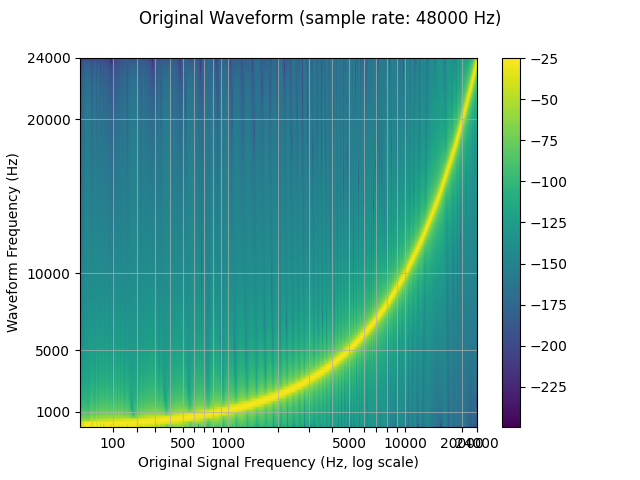
Now we resample (downsample) it.
We see that in the spectrogram of the resampled waveform, there is an artifact, which was not present in the original waveform.
resample_rate = 32000
resampler = T.Resample(sample_rate, resample_rate, dtype=waveform.dtype)
resampled_waveform = resampler(waveform)
plot_sweep(resampled_waveform, resample_rate, title="Resampled Waveform")
Audio(resampled_waveform.numpy()[0], rate=resample_rate)
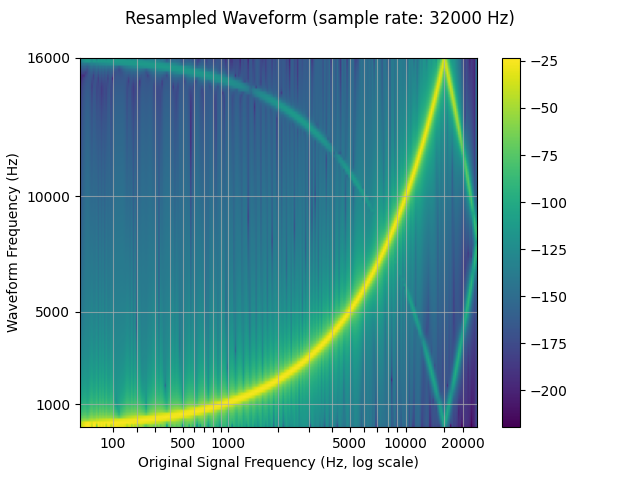
Controling resampling quality with parameters
Lowpass filter width
Because the filter used for interpolation extends infinitely, the
lowpass_filter_width parameter is used to control for the width of
the filter to use to window the interpolation. It is also referred to as
the number of zero crossings, since the interpolation passes through
zero at every time unit. Using a larger lowpass_filter_width
provides a sharper, more precise filter, but is more computationally
expensive.
sample_rate = 48000
resample_rate = 32000
resampled_waveform = F.resample(waveform, sample_rate, resample_rate, lowpass_filter_width=6)
plot_sweep(resampled_waveform, resample_rate, title="lowpass_filter_width=6")
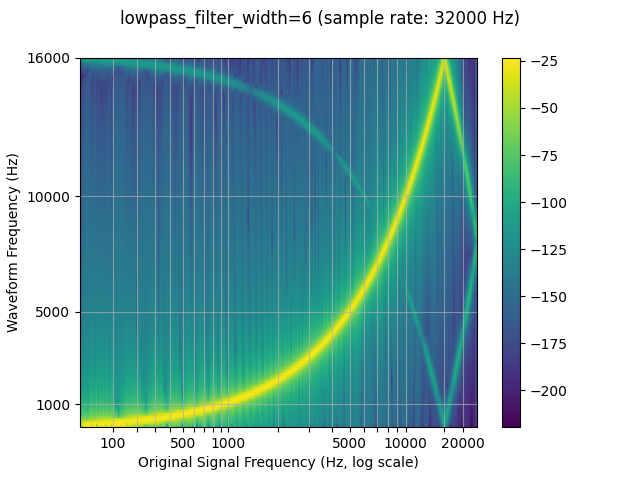
resampled_waveform = F.resample(waveform, sample_rate, resample_rate, lowpass_filter_width=128)
plot_sweep(resampled_waveform, resample_rate, title="lowpass_filter_width=128")
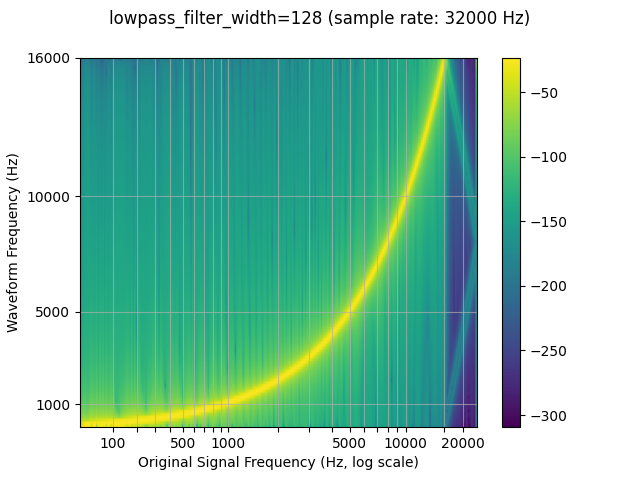
Rolloff
The rolloff parameter is represented as a fraction of the Nyquist
frequency, which is the maximal frequency representable by a given
finite sample rate. rolloff determines the lowpass filter cutoff and
controls the degree of aliasing, which takes place when frequencies
higher than the Nyquist are mapped to lower frequencies. A lower rolloff
will therefore reduce the amount of aliasing, but it will also reduce
some of the higher frequencies.
sample_rate = 48000
resample_rate = 32000
resampled_waveform = F.resample(waveform, sample_rate, resample_rate, rolloff=0.99)
plot_sweep(resampled_waveform, resample_rate, title="rolloff=0.99")
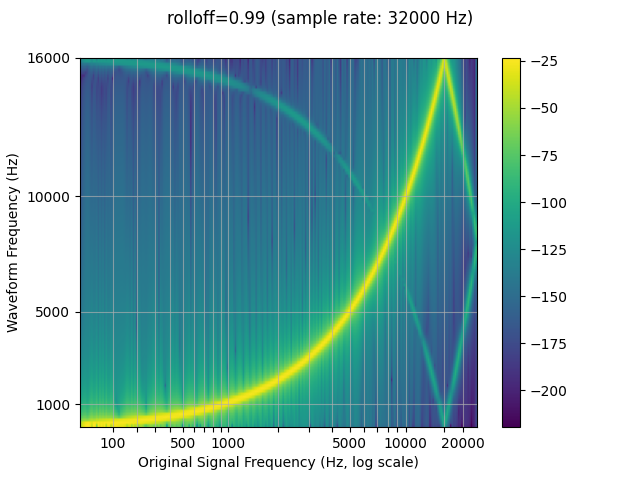
resampled_waveform = F.resample(waveform, sample_rate, resample_rate, rolloff=0.8)
plot_sweep(resampled_waveform, resample_rate, title="rolloff=0.8")
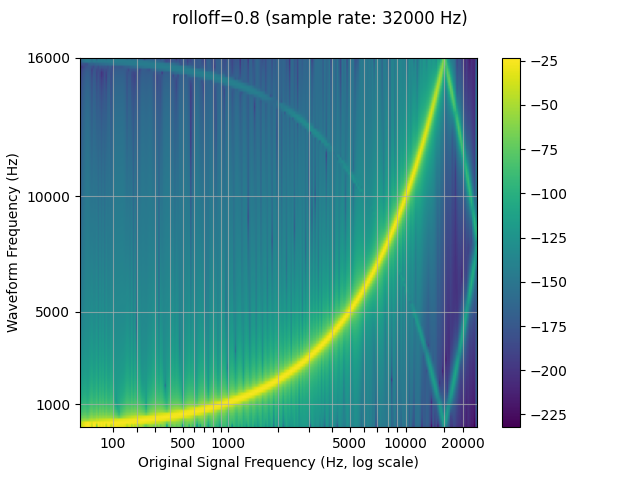
Window function
By default, torchaudio’s resample uses the Hann window filter, which is
a weighted cosine function. It additionally supports the Kaiser window,
which is a near optimal window function that contains an additional
beta parameter that allows for the design of the smoothness of the
filter and width of impulse. This can be controlled using the
resampling_method parameter.
sample_rate = 48000
resample_rate = 32000
resampled_waveform = F.resample(waveform, sample_rate, resample_rate, resampling_method="sinc_interpolation")
plot_sweep(resampled_waveform, resample_rate, title="Hann Window Default")
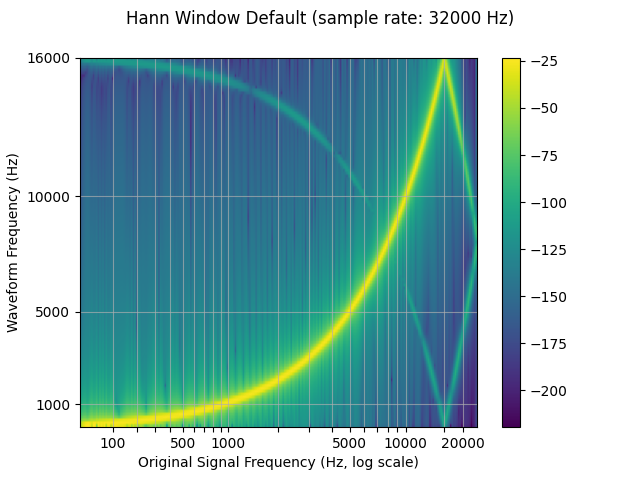
resampled_waveform = F.resample(waveform, sample_rate, resample_rate, resampling_method="kaiser_window")
plot_sweep(resampled_waveform, resample_rate, title="Kaiser Window Default")
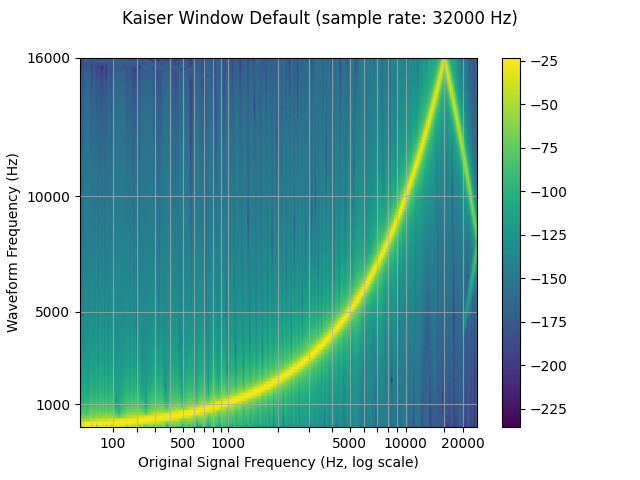
Comparison against librosa
torchaudio’s resample function can be used to produce results similar to
that of librosa (resampy)’s kaiser window resampling, with some noise
sample_rate = 48000
resample_rate = 32000
kaiser_best
resampled_waveform = F.resample(
waveform,
sample_rate,
resample_rate,
lowpass_filter_width=64,
rolloff=0.9475937167399596,
resampling_method="kaiser_window",
beta=14.769656459379492,
)
plot_sweep(resampled_waveform, resample_rate, title="Kaiser Window Best (torchaudio)")
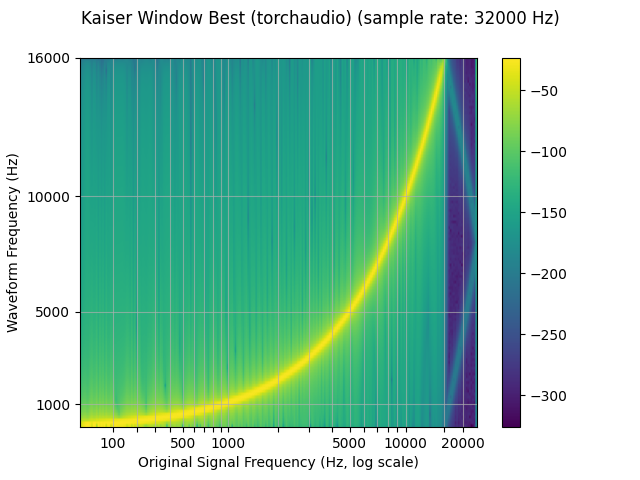
librosa_resampled_waveform = torch.from_numpy(
librosa.resample(waveform.squeeze().numpy(), orig_sr=sample_rate, target_sr=resample_rate, res_type="kaiser_best")
).unsqueeze(0)
plot_sweep(librosa_resampled_waveform, resample_rate, title="Kaiser Window Best (librosa)")
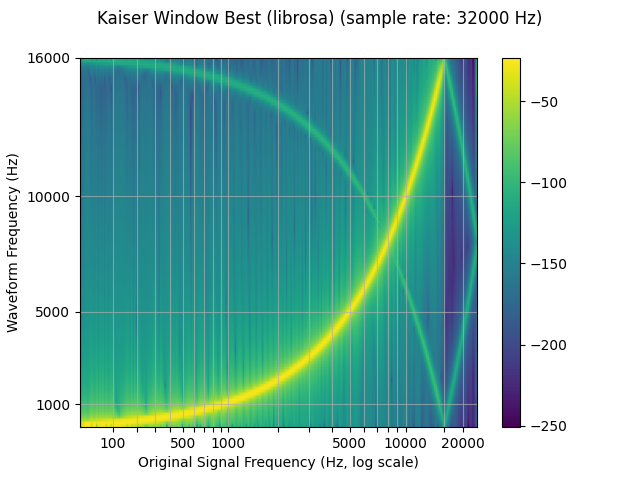
mse = torch.square(resampled_waveform - librosa_resampled_waveform).mean().item()
print("torchaudio and librosa kaiser best MSE:", mse)
Out:
torchaudio and librosa kaiser best MSE: 2.08069011536601e-06
kaiser_fast
resampled_waveform = F.resample(
waveform,
sample_rate,
resample_rate,
lowpass_filter_width=16,
rolloff=0.85,
resampling_method="kaiser_window",
beta=8.555504641634386,
)
plot_sweep(resampled_waveform, resample_rate, title="Kaiser Window Fast (torchaudio)")
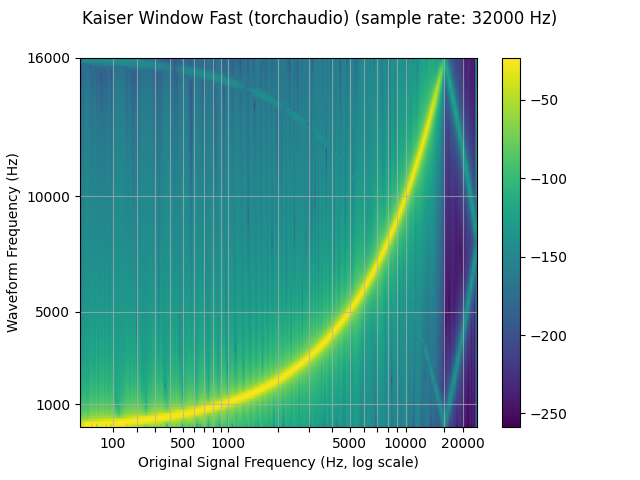
librosa_resampled_waveform = torch.from_numpy(
librosa.resample(waveform.squeeze().numpy(), orig_sr=sample_rate, target_sr=resample_rate, res_type="kaiser_fast")
).unsqueeze(0)
plot_sweep(librosa_resampled_waveform, resample_rate, title="Kaiser Window Fast (librosa)")
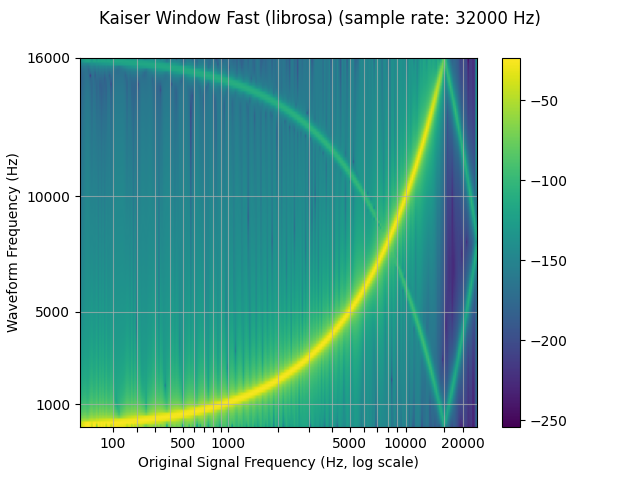
mse = torch.square(resampled_waveform - librosa_resampled_waveform).mean().item()
print("torchaudio and librosa kaiser fast MSE:", mse)
Out:
torchaudio and librosa kaiser fast MSE: 2.5200744248600685e-05
Performance Benchmarking
Below are benchmarks for downsampling and upsampling waveforms between
two pairs of sampling rates. We demonstrate the performance implications
that the lowpass_filter_wdith, window type, and sample rates can
have. Additionally, we provide a comparison against librosa’s
kaiser_best and kaiser_fast using their corresponding parameters
in torchaudio.
To elaborate on the results:
a larger
lowpass_filter_widthresults in a larger resampling kernel, and therefore increases computation time for both the kernel computation and convolutionusing
kaiser_windowresults in longer computation times than the defaultsinc_interpolationbecause it is more complex to compute the intermediate window values - a large GCD between the sample and resample rate will result in a simplification that allows for a smaller kernel and faster kernel computation.
def benchmark_resample(
method,
waveform,
sample_rate,
resample_rate,
lowpass_filter_width=6,
rolloff=0.99,
resampling_method="sinc_interpolation",
beta=None,
librosa_type=None,
iters=5,
):
if method == "functional":
begin = time.monotonic()
for _ in range(iters):
F.resample(
waveform,
sample_rate,
resample_rate,
lowpass_filter_width=lowpass_filter_width,
rolloff=rolloff,
resampling_method=resampling_method,
)
elapsed = time.monotonic() - begin
return elapsed / iters
elif method == "transforms":
resampler = T.Resample(
sample_rate,
resample_rate,
lowpass_filter_width=lowpass_filter_width,
rolloff=rolloff,
resampling_method=resampling_method,
dtype=waveform.dtype,
)
begin = time.monotonic()
for _ in range(iters):
resampler(waveform)
elapsed = time.monotonic() - begin
return elapsed / iters
elif method == "librosa":
waveform_np = waveform.squeeze().numpy()
begin = time.monotonic()
for _ in range(iters):
librosa.resample(waveform_np, orig_sr=sample_rate, target_sr=resample_rate, res_type=librosa_type)
elapsed = time.monotonic() - begin
return elapsed / iters
configs = {
"downsample (48 -> 44.1 kHz)": [48000, 44100],
"downsample (16 -> 8 kHz)": [16000, 8000],
"upsample (44.1 -> 48 kHz)": [44100, 48000],
"upsample (8 -> 16 kHz)": [8000, 16000],
}
for label in configs:
times, rows = [], []
sample_rate = configs[label][0]
resample_rate = configs[label][1]
waveform = get_sine_sweep(sample_rate)
# sinc 64 zero-crossings
f_time = benchmark_resample("functional", waveform, sample_rate, resample_rate, lowpass_filter_width=64)
t_time = benchmark_resample("transforms", waveform, sample_rate, resample_rate, lowpass_filter_width=64)
times.append([None, 1000 * f_time, 1000 * t_time])
rows.append("sinc (width 64)")
# sinc 6 zero-crossings
f_time = benchmark_resample("functional", waveform, sample_rate, resample_rate, lowpass_filter_width=16)
t_time = benchmark_resample("transforms", waveform, sample_rate, resample_rate, lowpass_filter_width=16)
times.append([None, 1000 * f_time, 1000 * t_time])
rows.append("sinc (width 16)")
# kaiser best
lib_time = benchmark_resample("librosa", waveform, sample_rate, resample_rate, librosa_type="kaiser_best")
f_time = benchmark_resample(
"functional",
waveform,
sample_rate,
resample_rate,
lowpass_filter_width=64,
rolloff=0.9475937167399596,
resampling_method="kaiser_window",
beta=14.769656459379492,
)
t_time = benchmark_resample(
"transforms",
waveform,
sample_rate,
resample_rate,
lowpass_filter_width=64,
rolloff=0.9475937167399596,
resampling_method="kaiser_window",
beta=14.769656459379492,
)
times.append([1000 * lib_time, 1000 * f_time, 1000 * t_time])
rows.append("kaiser_best")
# kaiser fast
lib_time = benchmark_resample("librosa", waveform, sample_rate, resample_rate, librosa_type="kaiser_fast")
f_time = benchmark_resample(
"functional",
waveform,
sample_rate,
resample_rate,
lowpass_filter_width=16,
rolloff=0.85,
resampling_method="kaiser_window",
beta=8.555504641634386,
)
t_time = benchmark_resample(
"transforms",
waveform,
sample_rate,
resample_rate,
lowpass_filter_width=16,
rolloff=0.85,
resampling_method="kaiser_window",
beta=8.555504641634386,
)
times.append([1000 * lib_time, 1000 * f_time, 1000 * t_time])
rows.append("kaiser_fast")
df = pd.DataFrame(times, columns=["librosa", "functional", "transforms"], index=rows)
df.columns = pd.MultiIndex.from_product([[f"{label} time (ms)"], df.columns])
print(f"torchaudio: {torchaudio.__version__}")
print(f"librosa: {librosa.__version__}")
display(df.round(2))
Out:
torchaudio: 0.12.0
librosa: 0.9.1
downsample (48 -> 44.1 kHz) time (ms)
librosa functional transforms
sinc (width 64) NaN 15.23 0.44
sinc (width 16) NaN 24.25 0.40
kaiser_best 34.52 27.59 0.42
kaiser_fast 17.58 21.90 0.38
torchaudio: 0.12.0
librosa: 0.9.1
downsample (16 -> 8 kHz) time (ms)
librosa functional transforms
sinc (width 64) NaN 1.21 0.73
sinc (width 16) NaN 0.59 0.34
kaiser_best 12.36 2.03 0.82
kaiser_fast 4.39 0.73 0.36
torchaudio: 0.12.0
librosa: 0.9.1
upsample (44.1 -> 48 kHz) time (ms)
librosa functional transforms
sinc (width 64) NaN 32.91 0.44
sinc (width 16) NaN 35.77 0.37
kaiser_best 35.07 29.64 0.46
kaiser_fast 12.37 22.09 0.40
torchaudio: 0.12.0
librosa: 0.9.1
upsample (8 -> 16 kHz) time (ms)
librosa functional transforms
sinc (width 64) NaN 0.78 0.35
sinc (width 16) NaN 0.50 0.19
kaiser_best 12.69 0.90 0.39
kaiser_fast 5.28 0.66 0.22
Total running time of the script: ( 0 minutes 5.492 seconds)



